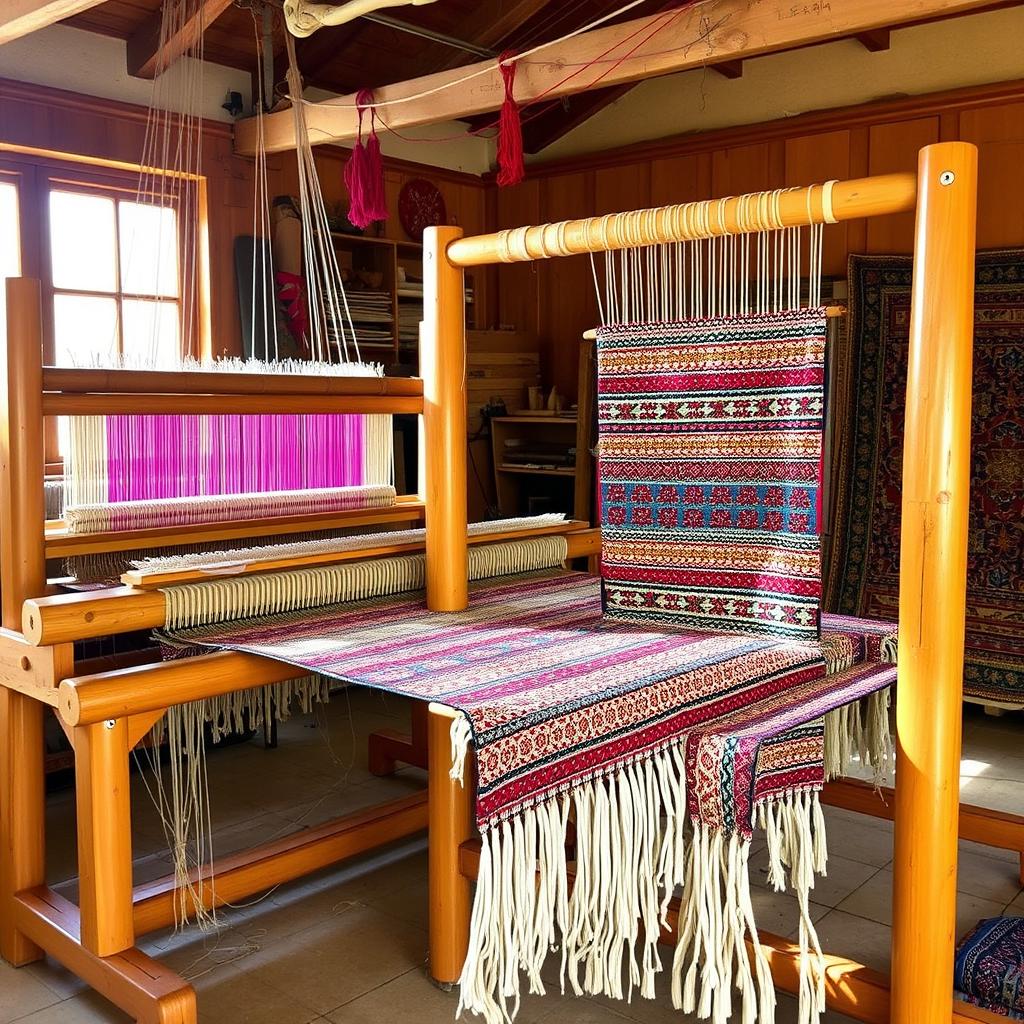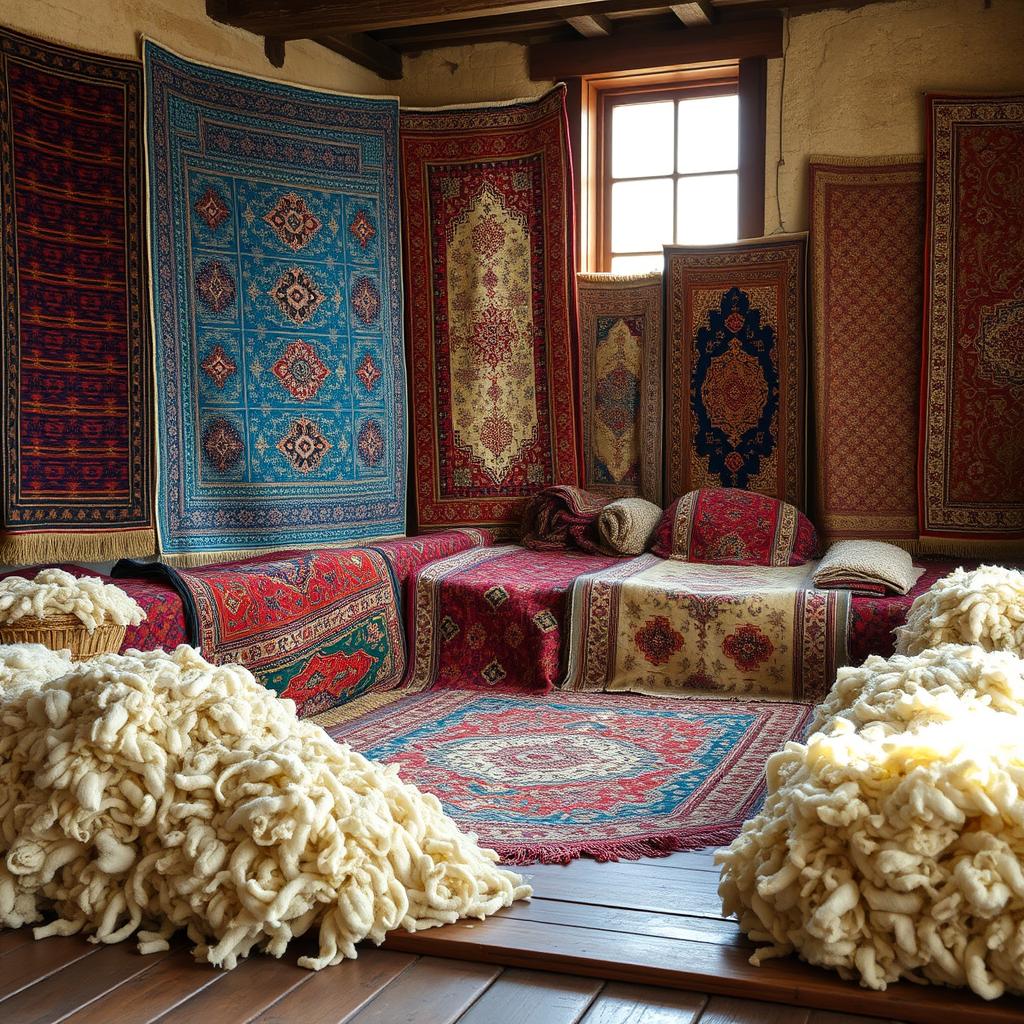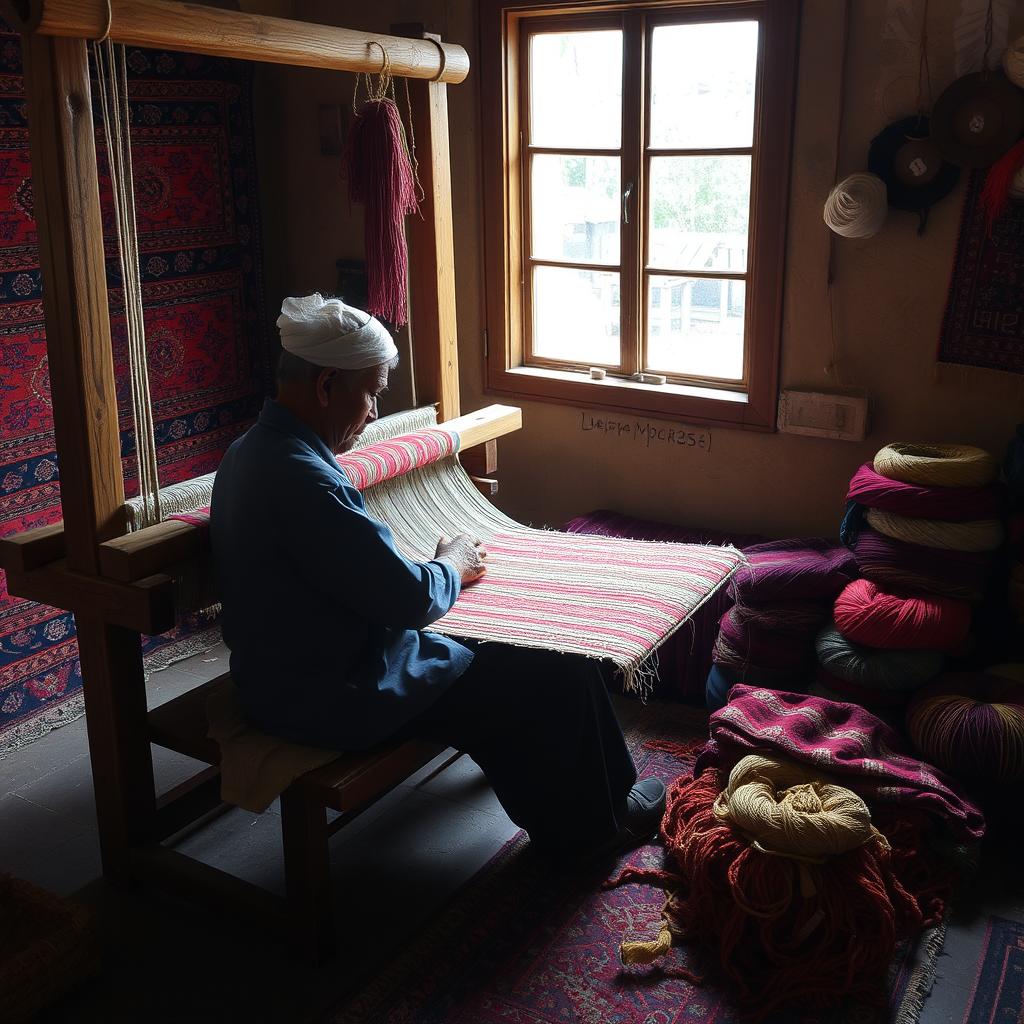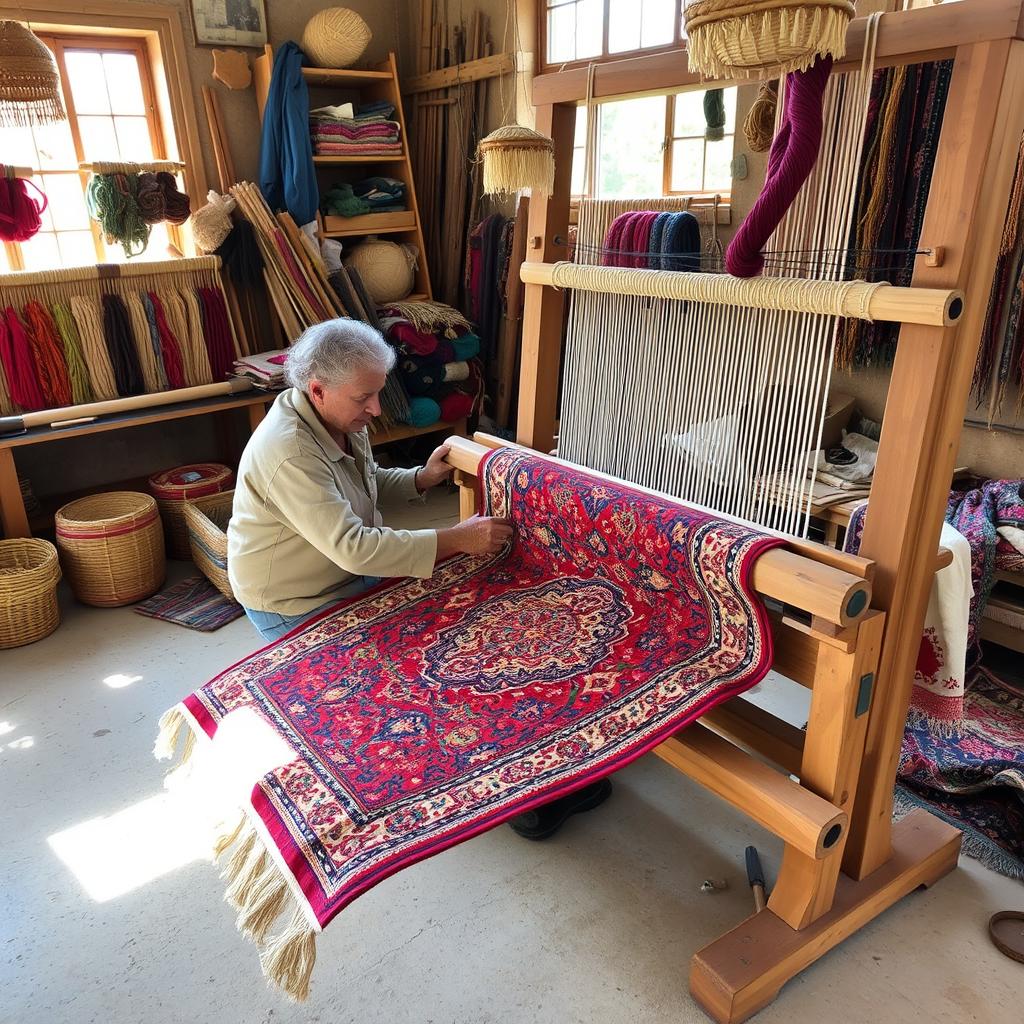Imagine stepping into a world where carpet making is a centuries-old art. This guide explores the world of traditional carpet making. It shows the techniques, materials, and cultural importance that have lasted for ages. Join us as we see how raw fibers become stunning, unique masterpieces that inspire and captivate. But what makes traditional carpet making special? What secrets are hidden in this ancient craft? Get ready to be amazed as we uncover the stories and traditions behind this art. We’ll reveal the mysteries of this captivating craft.
Click to use Silverigroup personal shopper services
Key Takeaways:
- Discover the ancient origins and evolution of traditional carpet making across diverse cultures
- Explore the essential tools, materials, and techniques used in the handcrafting of carpets
- Understand the intricate setup and maintenance of traditional carpet looms
- Learn about the selection and preparation of natural fibers for optimal weaving
- Dive into the step-by-step process of creating handmade carpets using traditional methods
The Rich History of Traditional Carpet Making
The history of carpet weaving goes back to ancient times. It has grown through many cultures. From the detailed hand-knotted rugs of Persia to the colorful Persian rug designs loved by all, it shows the skill and creativity of past and present artisans.
Ancient Origins of Carpet Weaving
The oldest carpets were made in the 5th century B.C. The Pazyryk carpet found in Siberia is a great example. It shows the advanced carpet weaving techniques of ancient times.
Evolution Through Different Cultures
Carpet making spread around the world, changing with each culture. The Persian Empire was key in making hand-knotted rugs and Persian rug designs famous for their beauty and skill.
Click to buy antique rugs from Silverigroup
Key Historical Weaving Centers
Over time, some places became famous for their carpet weaving. Iran’s Tabriz, Kashan, and Isfahan, and Uzbekistan’s Samarkand, were known for their amazing hand-knotted rugs and the talent of their makers.
| Historical Weaving Center | Signature Styles and Techniques |
|---|---|
| Tabriz, Iran | Intricate floral and geometric Persian rug designs, renowned for their fine knotting and vibrant colors |
| Kashan, Iran | Luxurious hand-knotted rugs featuring opulent patterns and a high knot count |
| Samarkand, Uzbekistan | Vibrant, boldly patterned carpets reflecting the cultural diversity of the Silk Road region |
The history of carpet making shows the lasting beauty and cultural value of this craft. From its ancient beginnings to its global appeal, hand-knotted rugs and Persian rug designs still amaze and inspire people everywhere.

Essential Tools and Materials for Traditional Carpet Making
Making handmade carpets the old way needs special tools and materials. At the core is the traditional carpet loom, where rug artisans weave their works of art from natural fiber carpets. Each loom is designed for the unique needs of the rug artisans and their carpets.
Carpet makers also use many specialized tools, including:
- Shuttles for weaving the weft threads
- Shears for trimming the pile
- Hooks for pulling and securing the knots
- Beaters for compacting the weft threads
- Dye pots and natural pigments for coloring the fibers
The choice of natural fibers like wool, silk, or cotton is key. These fibers are picked for their strength, softness, and dye retention. This ensures the carpets are beautiful and last long. By learning to use these tools and materials, rug artisans create unique, detailed carpets. Each tool and material is crucial in making these timeless pieces. This keeps the tradition of handmade carpet making alive.
Understanding Traditional Carpet Looms and Their Setup
The art of making traditional carpets is based on old weaving techniques. At the center of this process are the traditional carpet looms. Each loom has its own design and purpose. Knowing about the different looms and how to set them up is key to keeping the heritage of traditional carpet weaving techniques alive.
Types of Traditional Looms
There are many types of traditional carpet looms, each suited for specific weaving traditions. Here are some of the most common ones:
- Vertical Looms: These looms stand upright, making it easier to weave large carpets with detailed patterns.
- Horizontal Looms: Known as ground looms, they are used for weaving smaller, detailed traditional carpet looms.
- Drawloom: A special loom for making complex, multi-patterned carpets with the help of heddles and pulleys.
Proper Loom Installation
Setting up a traditional carpet loom correctly is vital for good results. This involves aligning the frame, securing the warp threads, and adjusting the tension. This creates a solid base for weaving.
Maintenance Requirements
Keeping traditional carpet looms in good condition is crucial for the quality and life of handmade carpets. Regular cleaning, oiling of parts, and fixing any issues are important. By doing this, weavers can keep their carpet weaving techniques working well.

Selecting and Preparing Natural Fibers
Creating beautiful, durable natural fiber carpets and hand-knotted rugs starts with selecting and preparing natural fibers. These fibers come from plants and animals. They give these timeless floor coverings their unique character and quality.
Wool, silk, cotton, and jute are common natural fibers used in carpet making. Each fiber has its own special properties. For example, wool is soft, warm, and resilient. Silk adds a lustrous sheen and superior strength. Cotton is cool and breathable, while jute has a rustic, earthy charm. Before these fibers can be woven into magnificent carpets and rugs, they must be prepared. This involves cleaning, carding, and spinning the fibers. Carding aligns the fibers and removes impurities, ensuring a smooth surface for weaving.
| Fiber Type | Characteristics | Applications |
|---|---|---|
| Wool | Soft, warm, and resilient | Traditional hand-knotted rugs, high-end carpets |
| Silk | Lustrous sheen, superior strength | Luxury carpets, decorative accents |
| Cotton | Cool, breathable texture | Casual, contemporary carpets |
| Jute | Rustic, earthy charm | Natural fiber carpets, eco-friendly flooring |
By carefully selecting and preparing these natural fibers, master weavers and carpet makers create exceptional natural fiber carpets and hand-knotted rugs. These pieces capture the timeless beauty and unparalleled quality of traditional carpet making.

Making Handmade Carpets Traditionally: Step-by-Step Process
Making a handmade carpet is a tradition that needs careful attention and deep knowledge. It starts with warping the loom and ends with adding intricate patterns. This process shows the skill and craftsmanship of master artisans.
Warping the Loom
The first step is warping the loom. This means arranging the warp threads in a specific pattern. Weavers must make sure the tension is even and the warp is spread out right. This sets the stage for a beautiful hand-knotted rug.
Knotting Techniques
- Then, the weavers start knotting. They use traditional carpet weaving techniques like the Persian and Turkish knots. These knots make the carpet dense and durable.
- Each knot is tied by hand. Weavers use their fingers to get the tension and symmetry just right.
Pattern Implementation
Adding the pattern is a hard but rewarding task. Artisans bring complex designs to life in the carpet. They weave motifs and symbols that show the region’s rich culture. This stage is where the carpet’s true beauty is seen.
Traditional Design Patterns and Motifs
Handmade carpets showcase a world of beauty through their designs. Each region has its own style, from persian rug designs to navajo weaving styles and tapestry weaving. These designs tell stories and reflect the culture of their makers.
Persian rugs often feature natural motifs like flowers and leaves. These designs are not just pretty; they carry deep meanings. They symbolize fertility, protection, and the balance of the universe. Navajo weaving styles are different, with bold and geometric designs. These patterns reflect the Navajo’s deep connection to their land and beliefs.
Tapestry weaving brings stories to life with detailed scenes. These works of art show the weavers’ skill and creativity. They are lasting reminders of human talent. Handmade carpets celebrate the rich heritage and creativity of cultures. They inspire us to learn, value, and protect these art forms.
Natural Dyeing Techniques and Color Selection
In traditional carpet making, natural dyes are key to keeping heritage alive. These dyes, made from plants, give natural fiber carpets a unique look. They also carry deep cultural meanings.
Plant-Based Dyes
Traditional carpet making uses a wide range of plant-based dyes. Colors like madder root’s bright red and indigo’s earthy blue have been used for ages. These dyes create the stunning colors found in heritage craftsmanship. Artisans carefully make and apply these dyes, keeping the carpets looking timeless.
Color Symbolism
Colors in traditional carpet making mean a lot. They show the culture and beliefs of the weavers. For example, madder root’s deep red stands for strength, while indigo’s blue means calm and spiritual connection. Knowing these colors’ meanings helps keep natural fiber carpets true to their heritage.
Dyeing Process
- Careful selection of natural dyes
- Preparation of fiber materials
- Dyeing techniques, such as mordanting and overdyeing
- Precise control of temperature and pH levels
- Meticulous attention to detail throughout the dyeing process
The dyeing process for natural fiber carpets shows the skill of traditional makers. Each step is done with great care. This ensures the carpets’ colors are vibrant and last long, capturing the essence of heritage craftsmanship. Traditional carpet makers keep their culture alive through natural dyeing. They weave their stories into every carpet, keeping natural fiber carpets beautiful and meaningful.

Quality Control and Finishing Touches
In the world of handmade carpets, the journey from start to finish is amazing. It shows the skill and hard work of rug artisans. The quality control and finishing touches are key to making these rugs last and look great.
Shearing is a crucial step in making a carpet. Rug artisans carefully trim the surface. This makes the carpet look smooth and even, bringing out the patterns and colors. After shearing, the carpet gets a thorough wash. This removes dirt and leaves the carpet clean and bright. It also makes the colors pop and ensures the rug stays beautiful over time. The last step is a detailed check by experienced rug artisans. They look over every part of the carpet. This ensures the rug is perfect in quality and beauty, making it a valuable addition to any home.
| Quality Control Measure | Purpose |
|---|---|
| Shearing | Creates a smooth, uniform finish and maintains the structural integrity of the hand-knotted rug. |
| Washing | Removes any residual dirt or debris, enhances the vibrancy of colors, and sets the dyes. |
| Final Inspection | Ensures each handmade carpet meets the highest standards of craftsmanship and durability. |
Rug artisans put a lot of effort into making each carpet perfect. They ensure every hand-knotted carpet is a masterpiece. It’s ready to add beauty and quality to any space.
Preserving Traditional Carpet Making Skills
Making handmade carpets is a treasured skill that needs to be kept alive. As the world changes, efforts are made to protect these old ways. This ensures they stay alive for the future.
Apprenticeship Programs
Apprenticeship programs are key in keeping these skills alive. They match skilled weavers with young learners. This way, the knowledge and techniques passed down through generations are kept safe. Apprentices learn everything, from picking the right fibers to creating complex patterns. This ensures the art of carpet making continues.
Cultural Preservation Efforts
There are many efforts to save the art of making handmade carpets. These include documenting old weaving methods, setting up training centers, and showcasing master artisans. They aim to keep this craft’s cultural value alive. These efforts also provide education and raise awareness. This helps keep the craft’s importance in our culture.
Modern Applications
There’s also a push to mix old carpet making techniques with new designs. Designers and makers are combining traditional skills with modern styles. This keeps the beauty and quality of traditional carpets relevant today. This approach helps preserve the art of making handmade carpets. It inspires a new appreciation for this ancient craft.
Conclusion
Making handmade carpets traditionally shows the lasting power of heritage craftsmanship. It has a long history, touching many cultures. This tradition has made a lasting impact on the world’s art.
The tools, materials, and techniques used in this craft show human creativity and hard work. We’ve learned a lot about this skillful art.
This journey has made us appreciate the skill and creativity in making these unique carpets. Keeping this craft alive is important for our cultural heritage. By supporting it, we help it thrive for future generations.
As we end this journey, we remember the importance of heritage craftsmanship. It connects the past and present, showing us the beauty of handmade art. Let’s keep this tradition alive, celebrating human creativity and the beauty of handmade crafts.
FAQ: Making handmade carpets traditionally
What are the key steps involved in making handmade carpets traditionally?
Making handmade carpets traditionally involves several steps. First, the loom is warped. Then, the carpet is knotted and patterns are added. Natural fibers are selected and prepared. Traditional looms and dyeing methods are used.
What are the different types of traditional carpet looms?
There are many types of traditional carpet looms. Each has its own features and uses. Vertical, horizontal, and hand-operated looms are examples. Keeping these looms in good condition is crucial for weaving.
How do artisans select and prepare natural fibers for traditional carpet making?
Artisans pick and prepare fibers like wool, silk, and cotton. They clean, card, and spin the fibers. This makes sure the fibers are of high quality and right for the carpet’s design and feel.
What are the traditional design patterns and motifs used in carpet weaving?
Traditional carpets feature many patterns and motifs. These designs come from different cultures and histories. Examples include Persian rugs and Navajo weaving. Each design has its own meaning and beauty.
How do artisans use natural dyes in traditional carpet making?
Artisans use plant-based dyes to color the fibers. They choose colors and their meanings carefully. They use special techniques to get the right shades and effects.
What are the quality control measures and finishing touches applied to handmade carpets?
Artisans take steps to ensure handmade carpets are durable and look great. They shear, wash, and inspect the carpets. This keeps the quality and craftsmanship high.
How are traditional carpet making skills being preserved and passed down?
Efforts are made to keep traditional carpet making alive. Apprenticeships, cultural programs, and modern production help. This keeps the craft relevant today.

